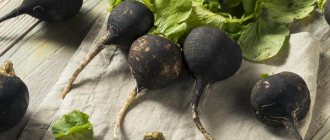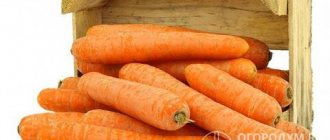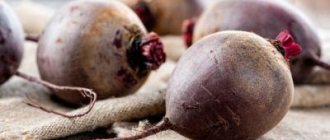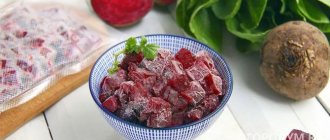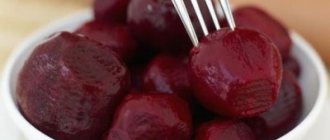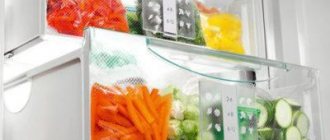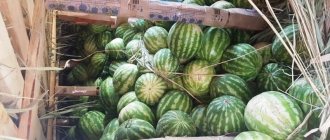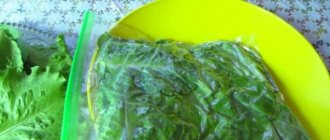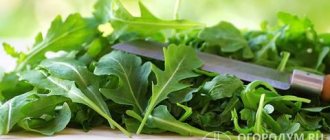The harvested carrots and beets can be preserved not only until the winter cold, but also until next autumn. A cellar is ideal for overwintering vegetables.
There are several ways to store root vegetables. Subject to certain rules, agricultural products can be stored both together and separately.
Let's take a closer look at how to properly store carrots and beets for the winter in a cellar, underground or basement.
Storage Methods
Create optimal conditions for vegetables
There are several ways to store carrots for the winter at home in the basement, provided that the requirements are met. Today, 8 of the best storage methods are used.
In cardboard or wooden containers
Vegetables are stored in such containers with or without filler.
Clean and selected root vegetables are placed in boxes made of cardboard or wood. Laying is done in layers, after which the container is covered and placed at a height of 15 cm from the wall. This way, moisture will not get into the container with root vegetables from the sweaty bottom surface, which will eliminate the risk of rotting vegetables.
The second option on how to preserve this vegetable is no less practical. Vegetables are placed in rows in boxes. A sand layer is placed on top. No more than 20 kg of root vegetables are placed in one container. This way the carrots don’t rot or spoil.
Sand-chalk mixture
There is another effective way to store carrots in the cellar in winter: using chalk and sand. Mix both components and moisten with a sprayer. For such storage, containers without cracks or holes are used. The vegetable is placed the way it grows in the garden: standing. All voids are filled with the prepared mixture.
In the same way, it is possible to preserve other root vegetables: beets, potatoes.
Chalk solution
Chalk is dissolved in water to a paste-like mass. Then each root crop is dipped into this mass, dried and placed in a wooden or cardboard box. Each layer is sprinkled with wet sand.
It is good to store carrots in the basement in winter, powdered with chalk. A glass of white powder is used for a bucket of root vegetables.
Storage benefits:
- this natural material has an alkaline property, which means it prevents the development of pathogenic bacteria on vegetables;
- the vegetable in chalk remains crispy, dense and juicy for a long time.
In the sawdust of pine needles
You can keep carrots fresh for a long time
In a large room, sawdust is poured onto a shelf, root vegetables are laid and the layers are repeated in this way until the vegetables run out. Leave a distance of about 10 cm between the sawdust and the wall.
In bags with onion peels
When peeling onions, do not throw away the husks: they will be useful for refilling root vegetables. The husks are placed at the bottom of the bag, then a layer of root vegetables is poured over. In such an environment, carrots do not rot and are not damaged by parasites.
The bags are tied, hung or placed on a shelf.
Sand pyramid
Storing carrots in the cellar in winter in this way will require small supplies of moistened sand. It is poured in the place chosen for storing the crop. Then a layer of root crops is laid in the same order and covered with sand. The second layer is laid across and covered again. This is done until a height of 1 m is reached.
During storage in this way, it is worth monitoring the condition of the sand. If it dries out, moisten it with a spray bottle.
In clay solution
Nobody wants to tinker with clay: it's dirty work. However, it is better to store carrots in the cellar this way.
The clay is poured into a capacious container, filled with water, and stirred. You should get a thick, homogeneous mixture. Root vegetables are placed in it and mixed so that the clay mass is evenly distributed on the surface of the vegetables.
The carrots are removed and laid out on the tent. After it dries, it is placed in any storage container.
Carrots wrapped in a clay layer are well preserved: they remain juicy and crispy for a long time, do not wither or dry out.
In cellophane
It is correct to store carrots in the cellar and in cellophane, observing the following conditions:
- root vegetables are well dried and cooled before placing in bags;
- to prevent moisture from accumulating inside, several holes are made in the bottom of the bags and the tops are tied tightly;
- all packaged bags are placed on a shelf and not on the floor, otherwise rotting of the carrots cannot be avoided;
- The status of the contents in the packages is monitored from time to time.
If moisture accumulates, the root vegetables are removed from the bag, dried and placed in another container.
How to store carrots? Useful tips. Gardening without hassle with HitsadTV
How to store carrots and beets
How to store carrots until spring.
How to use a caisson?
How to store carrots in a caisson? First of all, you should understand what a caisson is. A caisson is a waterproof structure. Simply put, this is a box or chamber that is externally equipped to prevent the passage of water from the outside.
To preserve carrots in this way, they must be washed well and the tops removed, then they should be dried well in the shade. After the carrots have dried sufficiently, they need to be placed in plastic bags. Root crops must be placed in the caisson on the same day.
Hint: you can leave a couple of bags in the refrigerator, since in winter it’s not every day that you can get carrots out of the caisson.
In addition to its taste, carrots are also a very healthy root vegetable. There are practically no dishes in cooking for which carrots would not be used. Carrots also make very tasty and refreshing freshly squeezed juices.
Carrots are also one of the main components in various cosmetics. It makes excellent masks, scrubs and creams. Carrots are also used in folk medicine as an effective remedy in the fight against various diseases.
Therefore, the question of storing carrots in winter is quite relevant in our time. We all love to eat carrots in the summer. But summer, as a rule, passes quickly, and you really want to pamper yourself with vegetables and fruits not only in the summer, but also in the winter.
And cunning sellers raise prices for vegetables and fruits almost 3 times in winter and, unfortunately, the price does not always correspond to the quality. In this regard, each of us should learn how to store carrots at home.
In this article we tried to provide comprehensive answers to all frequently asked questions. We hope this article about storing carrots helped you. Be healthy and happy!
How to store carrots in the cellar (basement)
The question of how to properly store carrots in the basement is especially troubling for novice truck drivers. Everyone knows that this root is very fancy. If you create the wrong conditions, you can lose your harvest: the carrots become flabby, sprout and rot.
Special requirements for storing root vegetables:
Before placing the root crop for underground storage, it is thoroughly cleaned. If necessary, the walls are disinfected using bleached slaked lime. If there is fungus in the storage, it is better to light the gray saber.
It is better to store carrots in the basement, subject to the following conditions:
- You can use wooden or cardboard boxes to store root vegetables.
- The carrots are laid in layers and tightly covered with a lid.
- It is better to place them on high shelves 15 centimeters from the wall, so that moisture does not get into the container with vegetables from the sweaty surface.
- The second option is to simply fill the layers with clean sand.
One box contains no more than 20 kg of root vegetables, so it is better to store them.
In the sand with chalk
Each gardener decides in his own way the question of how best to store carrots in the basement in winter.
First option:
- Prepare a mixture of wet sand and chalk. If the chalk is in sticks, then it is first crushed into powder.
- This will take a wooden box with a lid without holes.
- Root vegetables are placed in it, just as plant growth grows on a bed. A sand-chalk mixture is covered on top.
Second option:
- The chalk is diluted in water (completely insoluble) before mashing.
- He discards each carrot, dries it, and layers it in the box. Each layer is covered with sand.
- Good root vegetables are chalk powdered root vegetables. For every 10 kg of carrots take 200 g of white powder.
Why do gardeners think this is the best way to store carrots? It's all in chalk. First, this natural mineral, which has alkaline properties, reduces the likelihood of bacterial growth. Secondly, carrots do not dry out for a long time and remain juicy and dense.
In pine sawdust
Many gardeners consider the best way to store carrots in sawdust from coniferous plants. They contain phenolic substances that protect vegetables from putrefactive processes. What is the best way to use sawdust?
Do you think it is safe to store vegetables in pine sawdust?
Not really
You can place carrot layers in boxes, sprinkle with wood scraps. If the basement is large, the sawdust is poured directly onto the shelf (not onto the floor), and then the roots are distributed. Layers are repeated.
In bags with onion peels
When peeling onions, collect the skins, it is useful for storing carrots in the basement. Place it in a large bag and put carrots in it. Onion peels are an excellent remedy that will prevent carrots from rotting. Root vegetables are stacked in layers, filling the husks. Bags can be stacked on a shelf or hung on a nail.
Sand pyramids
This method of storing carrots will require almost dry sand. It can be poured onto the floor or shelf in the basement in a thick layer. Place the first layer of root vegetables, fill it with sand. The following layers are applied. And so on.
The height of the pyramid should not exceed 1 meter. While storing carrots, you need to monitor the condition of the sand. If it starts to dry out, the pyramid can be sprayed with a spray bottle.
In a clay shell
Many people may not like this method because the dirty work has to be done. But this option is considered the best.
With diluted liquid clay, she places the carrots in batches. The root vegetables should be gently stirred to form a shell without any omissions. Remove the vegetables until they are completely dry and can be stored in any container. It's not obligatory. What does this method do? Root vegetables do not dry out, they remain fresh and juicy for a long time, microorganisms do not damage carrots.
In plastic bags
This is a good option, but you need to follow some rules to keep the roots in the cellar until spring:
- Add only well-dried and cooled root vegetables:
- There are holes in the bag at the bottom to drain condensate; the top part is not tightly tied.
- The bags are placed on a stand and not on the floor.
- It is recommended to check periodically.
Can it be stored?
This method of preserving root crops is suitable for those gardeners who plant a small amount of vegetables for the winter.
Clean and healthy carrots are put into a bag in small portions (1-3 kg). The bags are put into the cellar, cold pantry or refrigerator.
Isolated from the external environment, the root crop is not exposed to negative effects:
- sudden increase or decrease in humidity in the storage;
- the spread of fungal spores from diseased vegetables.
But the vegetable itself releases heat and carbon dioxide during storage.
At a storage temperature of 0 degrees, 1 kg of carrots releases up to 5 mg of CO2 and 0.5 kcal of heat per day into the atmosphere. As the temperature in the room increases, the heat emission of the vegetable itself increases many times over. Over time, the amount of carbon dioxide in the bag accumulates and the temperature rises, which leads to an acceleration of metabolic processes in the root crop.
The root crop loses turgor (withers), the vitamins in it begin to deteriorate. When the storage temperature rises to 10-12 degrees, the biological sleep of the vegetable is interrupted, and its tops and roots begin to grow.
What is the best way to store carrots in the cellar?
It is very important to properly prepare the room; this has a significant impact on the final result. What you have to do:
- Ventilate the room. It must be fresh there.
- Disinfect the premises. A month before moving vegetables into the cellar, treat the walls with lime.
- Whitewash the basement. This will protect the walls from damage by fungus and bacteria.
In the beds
Get yourself thick plastic film, sand, shavings, fallen leaves and fertilizer. The vegetable will be aged under conditions as close as possible to natural ones, like in soil. You need to lay a layer of film on the shelf. A mixture of sand, shavings, and fallen leaves is poured on top. The layer should be thick. Dried carrots are placed vertically in an improvised bed. The top is covered with another layer of film and the edges are pinched. This way the harvest will remain on the shelves until spring.
In enamel pans
To preserve early ripening carrots of the right varieties in winter using this method, they are thoroughly washed and the tops are cut off. All root vegetables are thoroughly dried in the sun. They are placed tightly vertically in an enamel pan. Place a paper towel on top. The container is tightly closed. The pot with the plants is placed in a cool cellar with a high level of humidity. It will not deteriorate until the next harvest.
In plastic boxes
To store vegetables using this method, you should prepare some kind of filler: clay, sawdust, sand. Plastic boxes are well suited for carrots because they are less likely to rot than wooden ones, are susceptible to mold, and the spread of fungal diseases. These properties contribute to long-term winter storage. Carrots are laid in layers with any of the selected fillers.
In wooden boxes
There are two ways to store vegetables in this container - with or without filler. Brief description of each:
- No filler. Place the carrots in layers in the boxes and cover tightly. Place on high shelves approximately 15 cm from the wall. Place no more than 20 kg of root vegetables per box.
- With filler. This differs from the previous storage method in that the vegetables are laid in layers, each of which is sprinkled with sand.
Do I need to dry it?
In order to prepare the harvested carrots for long-term storage, it is necessary to carry out a number of measures:
- Clean root vegetables from dirt. Clods of earth are cleaned by hand. A knife or any other sharp metal objects injure the skin of carrots, which significantly reduces the shelf life of vegetables.
- Sort the harvested crops. At the same time, peeling the carrots from the soil, the root vegetables are sorted. First of all, vegetables with damage, cracks, or signs of spoilage are separated (such carrots go for processing). For long-term storage, large, dense, undamaged fruits are set aside. Small carrots are set aside separately. It is primarily consumed as food.
- Use a sharp, clean knife to trim the tops, or separate the greens from the root crop with your hands using the twisting method.
- Dry the carrots, leaving the vegetables in the garden for two hours.
- Before storing carrots for long-term storage, vegetables must be kept for five hours in a dark, well-ventilated place. During this time, the carrots cool, which allows them to accept fairly low air temperatures without stress.
Preparing the cellar
Before placing root crops in the basement for winter storage, the basement must be cleaned. Sweep away all the excess dirt, remove the remnants of last year’s spoiled vegetables. This will allow you to save carrots not only until spring, but even until the next harvest. Any last year's vegetable lying around in the basement will certainly begin to spread harmful bacteria to fresh, healthy vegetables.
After cleaning, the basement is well ventilated. The walls are disinfected with lime mortar. It is best to whitewash the walls with lime
When storing crops in the basement, it is very important that there are no traces of mold or mildew left on the basement walls.
If the basement is too wet, you can sprinkle slaked lime on the floor; it will partially absorb moisture from the air. Treating the basement with lime will do a good job if you have to store washed carrots. Usually it is stored simply slightly cleared of soil. If you wash it, it is more convenient to use later, but its shelf life decreases.
Shelf life
- in clay is a good storage method; it can be stored until the next harvest (12 months);
- in sand - approximately 6-9 months;
- in the package - 3-4 months.
Temperature
The optimal temperature in the basement is from -1 to +2 with a relative humidity of 90-96%. This temperature regime allows you to effectively preserve carrots for at least 6 months. When storing carrots in a warm basement, you should “powder” them with chalk before storing them. It will protect root crops from the effects of putrefactive bacteria.
Is the underground or basement suitable for storage until spring?
A clean and well-ventilated cellar is the optimal place to store carrots. It has enough space to accommodate the entire crop.
Maintaining stable temperature and humidity will extend the shelf life of vegetables.
Optimal temperature and humidity
Carrots will not freeze and germinate if stored at 0...+2 degrees.
An increase and decrease in temperature within 1-2 degrees is not critical. It is important not to allow constant changes. A one-time jump is not terrible, but regular changes will lead to the fact that vegetables will begin to rot, sprout or dry out
Air humidity should remain within 95%. The root crop consists of 90% water, so under unsuitable conditions it loses it very quickly.
If you notice that vegetables are starting to dry out, you need to increase the humidity in the room. To measure this indicator, a hygrometer is used. Read more about the temperature conditions for storing carrots here.
How to store carrots underground - in dry and wet sand
As a container for sand, medium-sized wooden boxes are usually chosen, into which up to 15 kilograms of root crops can be placed. Root crops of medium and large size are selected for storage, since those that are too small and short begin to deteriorate quickly. It is better to use them first. After harvesting, you need to let the carrots rest. In 3–4 days, the skin will dry out and the juices will stabilize. Then the crop is sorted - damaged and cracked roots are removed. The tops are trimmed (you can leave 3 cm).
Carrots should only be stored in clean, dry sand. If necessary, it also needs to be dried. Laying in a box is done as follows: a layer up to 2 centimeters thick is poured onto the bottom, a layer of carrots is laid out on it (with a distance of 0.5–1 centimeter between individual root crops). Then again a layer of sand, a layer of carrots, and so on until the very top. If the root crops come into contact with each other, then the entire layer may be infected by one rotten carrot. Also, root vegetables should not come into contact with the walls of the box.
How to store carrots underground in wet sand? Preparation for storage is similar to the previous method. Wet sand prevents the skin of root vegetables from drying out, and carrots remain fresh and juicy even in spring. Chalk is added to the sand, which acts as a preservative, stops the movement of juice inside the root vegetables and clogs the pores. With this storage method, the carrots are positioned vertically.
When is the best time to dig up vegetables?
Harvesting vegetables too early reduces the consumer quality of the root vegetable, preventing it from accumulating a sufficient amount of sugars. Staying in the garden for too long makes it possible to accumulate sugar in large quantities, which makes the vegetable very attractive to rodents.
Typically, harvesting times depend on the ripening period and weather. The ripening period of root crops is usually written on the seed packaging . It is better to dig up vegetables for storage when it is favorable according to the Lunar calendar. The days of the waning moon are considered the most favorable, but this factor can be neglected for the sake of suitable weather conditions.
Harvesting should begin at the time when the lower 2-3 shoots of the tops have turned yellow. Such root vegetables already have good consumer properties. We harvest beets before the first frost (having frozen, they will not be suitable for storage), and carrots can be safely left in the garden until the first snow (chilled root vegetables are better stored). In a rainy autumn, it is better to harvest the crops early, since the roots, saturated with moisture, will not be preserved well until spring and will be more susceptible to rotting.
IMPORTANT : Carrots can be dug up after the first frost, but beets must be removed before them! Frozen beets will begin to rot almost immediately.
You can learn about when to remove carrots from the garden for storage here.
Watch a video about the timing of harvesting carrots and beets:
Conditions, temperature and shelf life of carrots
In addition to location, conditions also include temperature, humidity, ventilation and lack of direct sunlight.
Temperature conditions. It doesn't matter whether the carrots are kept in the basement or on the balcony
It is important at what temperature carrots are stored. Recommended values – from zero to two degrees Celsius
But at zero and below, carrot fruits begin to freeze. Therefore, from time to time they need to be inspected for rot and damage. And if the thermometer rises from two to five degrees or above, the carrots will perceive this as a spring thaw and may sprout, and then wither. Humidity level. The optimal figure is 70%. This will protect the carrots from dehydration, lethargy and rot. You can slow down the evaporation of the liquid by removing the tops and sprinkling the layers with shavings and sand. Ventilation. The storage area must be ventilated constantly. This is the only way to avoid diseases, infection of carrots and preserve all the beneficial properties. Any container (boxes, bags) must have ventilation holes. It doesn’t hurt to place lime next to the container, which can absorb excess moisture and condensation that forms.
The more accurately you follow the recommendations, the higher the chances of increasing the shelf life of carrots to the maximum possible - 12 months.
Instead of a conclusion:
- the housewife can resort to several storage methods - freezing, basement or garden bed - and then decide on the best one;
- Do not place carrots near apples. Fruit ethylene is harmful to carrots. By the way, “neighborhood” next to potatoes is also not recommended;
- The best carrots for storage are “hundred-day carrots”. This means that no more than 3.5 months should pass from the moment of planting to ripening. Harvesting too early will negatively affect the benefits and taste, while harvesting too late will contribute to the accumulation of sugars. This will make the carrots especially tasty for rodents.
Previous VegetablesCan carrots be stored in the refrigerator and why do they wither? Next VegetablesTechnology for storing carrots in sand - choice of sand and conditions
Suitable varieties
Late-ripening varieties of root crops should be selected for storage . The following varieties and hybrids of carrots are best stored:
Gribovchanin F1.- Nantes 4.
- Incomparable.
- Nevis F1.
- Samson.
- Chance.
- Moscow winter.
- Incomparable.
Beet varieties suitable for long-term storage:
- Bravo.
- Incomparable.
- Bordeaux 237.
- Red ball.
- Podzimnyaya.
- Mulatto.
- Detroit.
- Nosovskaya flat.
There are no definite recommendations on how best to store it at home and where, in the basement or underground (underground), everyone decides for themselves experimentally. The determining factors for further preservation are:
- choice of root crop variety;
- preparation technology;
- room temperature;
- humidity mode;
- lack of excess oxygen supply;
- pest protection.
Among the storage methods, every gardener will find his own, the most convenient and profitable. First, you need to decide when and how to remove root crops for storage .
You can read more about suitable varieties of carrots and shelf life here, and here we talked about which varieties are suitable for long-term storage.
Possible problems
- The appearance of rot from excess moisture. This can be prevented if, when laying carrots, dip both ends in ash. Also, next to an open bag filled with carrots, you can put something that absorbs moisture - lime, newspapers, moss.
- You won't be able to sort through the contents of a large bag to find spoiled carrots. To solve this problem, do not initially put root vegetables in overly large bags. It would be better if they were transparent.
We have given you simple instructions to try out such a new and modern storage method as storing in plastic bags, including vacuum bags. In order to enjoy your own grown, harvested and stored carrots in winter, you must follow these rules. After all, your own carrots cannot be compared with store-bought ones. Keep this healthy and tasty vegetable healthy.
Useful tips
- It is useful to store beets with potatoes, they will give them excess moisture.
- When planting root crops, you can layer them with layers of fern leaves. They secrete phytoncides, helping vegetables fight fungi and rot.
- It is better to store small and large root vegetables separately. Use the former first, as the latter fit better.
- For storage in the garage or on the balcony, you can make a vegetable storage box from a box, insulating its walls and lid with polystyrene foam.
- If root vegetables are sprinkled with sand, it should first be disinfected at high temperature in the oven or in the sun.
Best Storage Methods
The cellar and basement are the best places for winter storage, because it is there that it is easiest to maintain the specified temperature and humidity. The cellar should not freeze during the winter. In good conditions, carrots can be safely stored for a whole year, until the next harvest, and you will have the opportunity to regularly receive fresh vitamins from your own garden at your table.
To understand how to store carrots in the cellar correctly, check out the following popular methods:
- Wooden boxes with a lid are one of the easiest ways. Carrots are simply neatly placed in boxes made of wood or thick cardboard. The boxes are closed with a lid and placed in the cellar at a distance of 10 - 15 centimeters from the walls. Sometimes the walls can become damp, but moisture should not get into our drawers. It is better not to place them on the floor, but to use a small stand. There is no need to make holes in the boxes; they should be tight enough. This storage method is quite compact and will allow you to place a significant amount of root vegetables even in a small cellar. Try to put no more than 20 kg of carrots in one box.
- Onion peel. Do not throw away the husks that remain in large quantities from the onion. Place it in large bags and place the carrots there too. The husk, on the one hand, will absorb excess moisture, and on the other, protect root crops from rotting and the proliferation of microorganisms. Try to roll each carrot in the peel, but you can just sprinkle it into individual layers. Tie the bags and lower them into the cellar or underground.
- Coniferous sawdust. In order to use this method, you need to sprinkle the root vegetables with sawdust from coniferous wood. The phenolic substances contained in the needles will protect root crops from rot and disease. You can put carrots in boxes from method 1 or any other container. You can simply pour sawdust onto the shelves in the cellar, place root vegetables on them and sprinkle another layer of sawdust on top. Sawdust should not be poured onto the floor or close to the walls of the cellar.
- Pyramids covered with sand. With this storage method, a thick layer of sand is poured onto the floor. The carrots are laid out in a row and covered with the next layer of sand. The second row of carrots is placed on top of the first in a checkerboard pattern. A layer of sand wakes up again, and so on. Pyramids should not exceed 1 meter in height. The sand for this method should be slightly damp, closer to dry. If the sand is completely dry, it should be periodically sprayed with water from a spray bottle to prevent the carrots from drying out. Root crops should not touch each other. It is advisable to sift and calcinate the sand before use for disinfection.
- Wet sand and chalk. It is necessary to mix clean, slightly damp sand with chalk powder. Place this mixture in a thick wooden box. Place the carrots in the sand, thick end up, sprinkle on top. Chalk will prevent bacteria from multiplying and will keep carrots fresh and tasty for a long time.
- Chalk solution. Chalk must be diluted with water to a homogeneous liquid state. Each root crop is soaked in this solution, dried and stored. You can simply “powder” the carrots with dry chalk powder. For 10 kg of carrots you will need about 200 g of chalk. The alkaline properties of chalk do not allow microorganisms to multiply.
- Shell made of liquid clay. A rather dirty storage method, but one of the most effective. Therefore, if the carrots in your cellar are constantly rotting and spoiling, use it, you will not regret it. Before storing root crops in the cellar, dilute the clay with water in a bucket until a uniform fluid mass is formed. Dip each carrot there and dry. The clay should completely cover the root crop. After drying, lower the carrots into the cellar and place them in boxes or baskets. You don't have to cover it with a lid.
- Plastic bags. Not the best way, but if there is no other storage option, pack dry root vegetables in thick plastic bags and put them in the cellar. The bags should be placed on a shelf or small stand. Several holes are made in the bottom of the bag through which the resulting condensate will drain. The bag does not tie.
Several recommendations for storing carrots
In addition to the basic rules, when organizing the storage of carrots, you should remember simple techniques that can increase the effectiveness of the chosen approaches:
- If the carrots have withered a little, you shouldn’t get rid of them. You can still try to restore it to use in the cooking process. We take the root vegetable, cut off a small layer from its tip and lower the product into a glass of water. We wait 2-3 hours. During this time, the component is able to become saturated with moisture and acquire its original appearance.
- You can also try to improve the texture of a soft vegetable. In this case, wash it thoroughly and cut off the skin from both ends. We completely immerse the workpiece in cold water for a couple of hours.
- If after cooking there are a few peeled carrots left, they can be stored in the refrigerator directly in a bowl, covered with a damp cloth. The product should be used within 1-2 days.
- For 3 days, peeled and washed carrots will retain their original freshness if you place them in a container with cold water and put them on the middle shelf of the refrigerator.
If traces of rotting appear on the surface of the root vegetable, it is not necessary to throw away the entire vegetable. Often it is enough to cut out the problem areas, and everything else can be put to use.
What if there is no hole?
If there is no cellar or pit for storing crops, you can use the following methods:
On the balcony
To store carrots on the balcony you need to prepare a plastic box, sawdust or sand
With this storage method, it is important that the temperature is not above 0 degrees, and sunlight does not penetrate the root crops, otherwise their quality will decrease. The carrots change color, begin to turn green, and their taste takes on a bitter aftertaste.
- Before laying, clean the root crops from the soil, wash and dry.
- Then pour sand onto the bottom of the box, the layer thickness is 2 cm. Lay the root vegetables in rows and cover them with sand again.
- Lay out root vegetables in the same way until they fill the entire height of the box.
- Place the container on a balcony or glassed-in loggia.
In a refrigerator
- If you choose the storage method in the refrigerator, then wash the crop and dry it for 2-3 hours.
- Cut off the tops, take cling film and wrap 3-4 vegetables tightly in 2-3 layers, and then in 2 more dense layers of film.
- In small batches, place the carrots in the refrigerator in a vegetable storage box.
- After this, make sure that it does not freeze.
Instead of plastic film, plastic bags are suitable; you can use jars and other containers. For storage in the freezer, carrot puree or a grated version is suitable.
Conservation
This method is perfect for those who live in a city apartment and do not have the opportunity to store crops in a basement or pit. To do this you will need carrots, brine (30 g of salt per 1 liter of water).
- Wash and peel the root vegetables.
- Place them in boiling water for 2-3 minutes.
- To make the brine, add salt, bring to a boil, pour the hot brine over the vegetables.
- Place the jars in a sterilizing container with salt water. Sterilize 1 liter container for 40 minutes.
How to preserve vegetables until spring?
In the garden
This method has the following features:
- During the last month of cutting the tops, you should not water the garden.
- To harvest the crop, choose a day preceded by a period without rain (preferably no rainfall for a week). Then the soil will not accumulate excess moisture.
- Trim already yellowed carrot tops; the ground level should correspond to the cutting area.
- Fill the bed with coarse sand. The layer should not be too thick, 2-5 cm is enough. At the same time, make sure that it completely covers not only the area with root crops, but also the surrounding area (1 m from the bed). Due to the sand, oxygen will flow to the surface of the earth.
- Cover with polyethylene. This can be done immediately before the onset of frost.
- Lay out the next layer of available materials. These can be tree leaves, peat, sawdust.
- Cover the insulating layer with polyethylene or roofing felt. Thanks to it, a thermal cushion is created, which allows you to preserve the crop, buried from the cold, for the winter. Carefully fix the roofing material or film with any available materials.
Further snowfalls will create additional protection from the cold climate, and after melting the root crops will be in perfect condition
Pay special attention to protecting carrots from rodents. These animals will not miss the opportunity to enjoy delicious vegetables in winter.
For protection, it is necessary to use spruce branches as insulation. It is enough to simply scatter them over the surface of the insulating layer.
You can find out more about how to preserve carrots in the garden until spring here.
Watch the video on how to store carrots directly in the garden.
In the hole
This method involves storing the harvested crop in an organized hole dug on the site.
Reference! It is necessary to follow not only the technology for organizing the storage location, but also the removal of root crops from the ground and preparing them for planting.
All these rules are completely simple, but they help preserve the crop for a long time with good quality indicators. First you need to carry out a number of preparatory activities:
- Before removing root crops from the ground, you should not water.
- Use a pitchfork for digging.
- Do not shake the soil from vegetables or hit them with a pitchfork. Such mechanical impact leads to the formation of microtraumas, which will worsen the safety of root crops and lead to premature rotting.
- Place the collected carrots to dry.
- After drying, remove excess soil.
- Trim the tops. Cut it off to the very top of the root crop. The height of the remaining greenery should not be more than 2-3 cm.
- Sorting the crop.
Now you can move on to selecting vegetables to put in the pit. Small specimens are suitable for this. The next step will be preparing the laying site. You need to choose a place that is not subject to flooding by meltwater in the spring. When the root crops have been selected, you can proceed to storing them for storage.
Important! Additionally, install repellers and traps containing poison. This will protect the vegetables from pests. The procedure is as follows:
The procedure is as follows:
- Dig a hole. Its depth in those areas where winters are mild and there is no deep freezing of the soil should not exceed 30-35 cm. In those regions where winters are severe, the depth of the pit should not be less than 50-60 cm. The width for both cases will be 50 cm.
- Place coarse sand at the bottom of the pit. The layer thickness is 2-5 cm. Sand prevents contact with the ground and provides air exchange.
- Place a layer of root vegetables. Cover them with sand until 10-15 cm remains for the edge of the pit.
- Cover with earth so that the top layer extends 8-10 cm above the edge of the hole. If the winter is harsh, then the top layer of earth can be 50 cm thick.
- Now you can move on to insulation. For these purposes, leaves from trees, peat, sawdust, and spruce branches are used.
If you plan to store carrots in the winter in a cellar or at home, then there are many excellent ways to preserve the root vegetable:
- How to store carrots at home if there is no cellar?
- How to store carrots in jars and boxes?
- Tips for storing carrots in the refrigerator.
- Where can you store carrots in an apartment?
- How to store carrots on the balcony?
- How to keep carrots fresh until spring?
- Is it possible to freeze grated carrots for the winter?
Storing carrots in the ground is an effective way to keep vegetables safe and sound until next spring; for these purposes, you can lay carrots directly on the garden bed or prepare a hole for them. In terms of implementation, this method is simple and does not take much time, although it requires compliance with all points. The method for storing beets is similar.
Preparing root vegetables for storage
The first thing you should take care of before wondering how to properly store carrots and beets in the cellar is timely harvesting.
Beetroot is a root crop that does not tolerate frost, so harvesting of this crop should be organized before frost begins, that is, in the third ten days of September - early October. For the southern regions, this period shifts by about 2-3 weeks (that is, cleaning there can be recommended to be carried out throughout October, adjusted for weather problems).
You need to choose a moderately warm sunny day so that the root vegetables have time to dry in the fresh air during this day. Thick roots of beets need to be trimmed with scissors or pruning shears, leaving no more than 1.5–2 cm in length, as well as green tops.
Carrots are ready for harvesting the moment they stop growing. This occurs when the ambient temperature drops to +4 °C.
If you harvest carrots for storage earlier, in a warmer time, there is a sharp temperature change - from warm, sun-warmed soil to a colder air environment, the quality of the crop will sharply decrease, you may lose some of the root crops: they may lose density and hardness and, accordingly, will not be saved.
The tops of carrots and beets must be removed immediately, cut with a knife or twisted by hand, leaving “tails” of about 1–1.5 cm. Greens should not be left on root vegetables for a long time, so that they do not “pump out” nutrients from the root vegetable.
Before storing carrots and beets, you should thoroughly clean the root crops of soil residues. They can then be soaked in a saline solution, which can help extend storage time by protecting them from the harmful effects of pathogens and pests.
The solution is prepared from water and salt in a ratio of 1000 ml of water per 250 g of salt.
Possible problems and solutions
During storage, problems may arise that affect the quality and shelf life of products. The most important ones are related to changes in temperature, humidity, and the appearance of fungus.
Every problem has its own solutions.
Change in temperature .
If the cellar is poorly insulated during the winter months, the temperature may drop or rise. If the thermometer shows a critical level below zero degrees, a bucket of smoldering coals can help out. When the temperature rises, the cellar should be ventilated.- Change in humidity . This indicator can be adjusted using salt and charcoal. Moisture-absorbing filler is poured into boxes and placed in the corners of the room.
- The appearance of mold . Lime is used to disinfect the cellar. It kills pathogenic fungi and dries the air at the same time.
To reduce fungal infection of root crops, it is useful to use plants that secrete phytoncides. To do this, carrots and beets are arranged with sprigs of fern, rowan, and tansy.
Carrot varieties that store well
In essence, no matter what variety of carrot you choose, it’s winter. Especially if you have a brick or concrete cellar, and not just a barrel buried in the ground. However, there are some varieties that, due to their special properties, are stored much better and spoil less than others.
Examples of such varieties:
- "Moscow Winter". An ideal variety for winter storage in a cellar or underground. The good taste and high yield of root crops will delight you even at the harvesting stage. The ripening speed is average.
- "Nantes". This is a variety with excellent taste and good keeping quality. When properly grown, it produces a rich harvest and is stored for a long time. Sings quickly.
- "Chantane." A variety of medium ripeness, high-yielding, sweet, with a wonderful aroma.
Also popular varieties are: “Vitaminnaya 6”, “Samson”, “Cascade”, “Nigel”.
Variety "Moscow Winter".
If you don’t know what type of carrots you have, then focus on the shape of the root vegetables. Round, short-fruited varieties (“Paris Carotel”) do not store very well; it is better to choose medium-sized conical-shaped root crops.
The importance of properly storing carrots for the winter
Proper placement and preparedness of the room for storing carrots are important conditions for a long shelf life, without loss. How to prepare the room:
- Preparations begin a month before laying. First, the room is ventilated and disinfected. The disinfection procedure is carried out using a sulfur bomb or bleach.
- In two weeks the walls are whitewashed. Copper sulfate must be added to the slaked lime solution. During whitewashing, it is recommended to use 0.5 liters of solution per 1 m2.
To avoid rotting and drying of root crops, special storage conditions must be observed. These include:
- temperature regime not lower than -1ºС and not higher than +2ºС;
- relative humidity from 90 to 95%;
- moderate ventilation.
Important: Even a slight change in temperature can cause drying, rotting or sprouting of root crops. At +5ºС carrots begin to sprout.
Proper preparation of the cellar for storage
The cellar in which the harvest will be stored must be safe for vegetables, fruits, and preparations.
To do this, the room is disinfected. Treatment is carried out in the summer (1-1.5 months before placement in food storage). You can prepare the composition for treating the cellar yourself using potassium permanganate, copper sulfate, and chlorine solution. Ready-made preparations can also be purchased at a hardware store. To prevent the appearance of mold and mildew, the walls of the storage facility are whitewashed with lime. After disinfection and preventive treatment, the basement or underground area must be ventilated and the ventilation operation checked. Only after this the storage is ready to place the crop in it. You can put carrots in the basement for storage: the vegetable will spend the winter in safe conditions.
Warm underground, damp basement and other difficult conditions
The key to the safety of the harvest stored in the underground or basement is stability of temperature and humidity. Careful preparation of carrots for storage will be in vain if the storage is damp or too warm. The room temperature must be stable, not fall below 0°C and not rise above +2°C. Humidity above 97% will also be detrimental to the crop.
The high level of groundwater in the area leads to an increase in humidity and the appearance of water in the storage. If you store carrots in a cellar for the winter in high humidity, they may rot.
In the underground of a wooden house it is difficult to maintain the required temperature regime. The operation of heating devices in winter leads to heating of the space under the floor. It will not be possible to store the crop in a warm room. If the floors are thermally insulated, then the temperature in the underground reaches negative values. In this case, storing vegetables and fruits for winter storage is also at risk.
Where and how can you keep them fresh at home?
You can store it at home (in an apartment), either on a glazed balcony, cellar (basement), or in a garden bed. But the best place to store vegetables is undoubtedly the cellar . It is always dark there, constant temperature and humidity are maintained.
You need to prepare the cellar in advance. Ventilate, if necessary, dry, treat against fungus, check for holes from rodents. To reduce humidity, you can place boxes of salt or charcoal in the corners of the cellar. If you whitewash the basement walls with quicklime, you can kill two birds with one stone: the lime will both disinfect and make the air drier.
TIP : To prevent rodents from eating, you can use baited traps, repellers, or treat the room with special products.
Useful properties of this vegetable
Many gardeners like this healthy vegetable; in particular, its roots are of great value - they contain a lot of vitamin A. Carrots are suitable for preparing salads or canned food for the winter. It is better to grow it in the garden - this way you will know with confidence that the vegetable does not contain any additives.
This vegetable contains vitamins of different groups - there is carotene. This substance, when it enters the human body, is converted into vitamin A. Carrots contain proteins, carbohydrates, minerals, as well as iron, potassium, phosphorus, copper, cobalt, fluorine, zinc, nickel, and iodine. There are also essential oils that cause an unusual smell.
Carrots contain beta-carotene, which has a positive effect on lung function. It also helps strengthen the retina of the eye.
Grated or chopped vegetables
How to store grated carrots? Having pre-grated or chopped vegetables in the kitchen is very convenient - it saves cooking time. To prevent grated carrots from spoiling, they should be placed in the freezer in a special container.
There are other ways to store peeled carrots. For example, it can be dried in a steam table - a device for heating food.
To do this, cut the carrots into pieces or circles, boil for 5-10 minutes and dry. Read more about how to dry carrots here.
If there is no special device, then you can put the vegetables on a baking sheet and leave them in the oven at 60 degrees. In this form, the fruits can be placed in containers for bulk products or a glass jar.
Another way to store grated carrots is as a savory snack. To prepare it, you need to cut the red root vegetable into strips and heat it in a frying pan in vegetable oil. Add onion, garlic and spices to taste, you can add soy sauce.
This snack is placed in jars and stored in the refrigerator. You can also screw it into sterilized containers, then add a spoonful of vinegar or citric acid to the solution.
Note! Carrots can also be stored in a processed form, such as dried, as a savory snack. You can also make carrot juice or sauce
Find out how to prepare very tasty and healthy dried carrots from our article.
Carrots are not just tasty, but also healthy vegetables. It contains a large amount of vitamin E and A, as well as vitamins C, D, K, P, PP and many others. The mineral composition of this fruit also includes a high content of magnesium, calcium, phosphorus and potassium.
All this is necessary for proper metabolism. It is very useful for children to eat carrots to strengthen the body. It is useful for anemia, as well as for the prevention of eye and immune system diseases.
Carrots increase their beneficial properties when cooked, so it is better to add them to soups and side dishes.
To ensure that carrots always end up on the table, it is better to stock up on them for a long time. Moreover, this vegetable is distinguished by the possibility of long-term storage.
The most important stage
How to store carrots? The storage itself needs to be prepared for the winter. The usual procedure for disposing of garbage, ventilation and disinfection will not take much effort and money, but will ensure the longest possible storage of vegetables. The most optimal temperature at which it is recommended to store carrots is +1 degree Celsius. The humidity in the room should be at 90-95%. To ensure this indicator, you can use ordinary plastic bags, because they prevent moisture from evaporating from the carrots. The package itself should be kept open. This is necessary so that the volume of carbon dioxide released by the root crop does not exceed the volume of oxygen. Otherwise, inventory will quickly deteriorate.
Many people wonder how to store carrots for the winter. However, not everyone knows that the solution to this problem can be the use of ordinary wet sand. This will help those who do not know how to store carrots in the cellar. You can moisten the sand with water (one liter per bucket). It is recommended to place carrots in boxes in layers. Each root crop should be surrounded by sand on all sides.
How to remove carrots from the garden for storage
Very important components of one process are carrot harvesting and storage for the winter. You need to dig carrots in dry, warm weather so that you can dry the crop immediately after you remove it from the garden.
It is best to dig carrots in the garden with a pitchfork, as there is less risk of damaging them. You need to lightly hold the carrots by the tops and pry them up with a pitchfork. You can also use a small garden shovel, and the worst thing is to dig carrots with a shovel. It can easily be damaged. In this case, it is better not to dig, but to dig up the crop in the garden bed, and then remove it with your hands, carefully pulling out the fruits. This is easy to do if the soil is dry and loose.
The most important thing is that the carrots must be whole, without scratches or cracks. Damaged carrots will not store well and will quickly rot.
- If you harvest carrots in dry, warm weather, then it will be enough to dry them in the open air before storing them in the basement for storage.
- If you harvest carrots in the rain, they will need to be dried under a roof in a shed or garage. To do this, spread the entire crop in one layer on newspapers or other dry bedding so that the root crops do not touch each other. It takes several days to dry before storing for the winter.
Storing carrots for the winter requires preliminary preparation. Vegetables must be dried and sorted (small ones and those that are too large are removed for eating). After harvesting, you need to remove the tops by cutting them with a sharp knife at a distance of 1–2 mm from the root itself.

